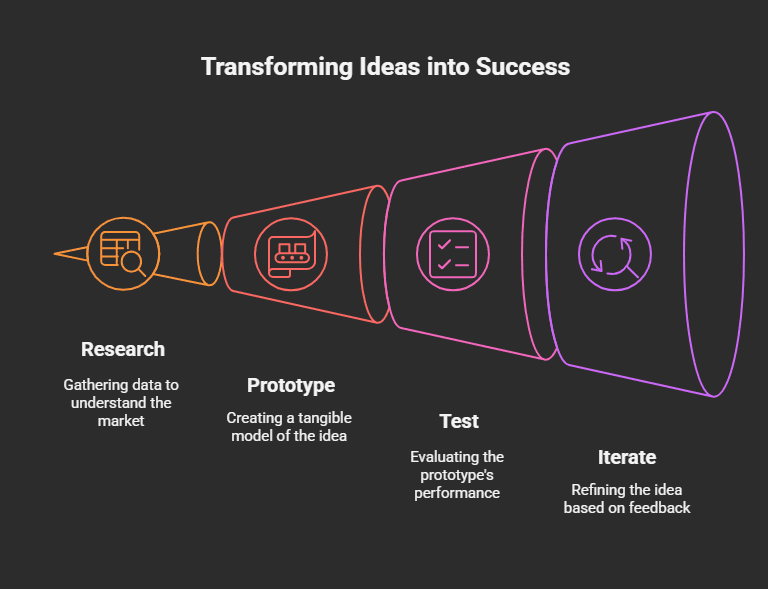Thinking of launching your dream venture? Exciting, right? But hold on, before you dive headfirst into the deep end, there’s a crucial pre-launch step that can save you a mountain of headaches (and dollars): validating your business idea. In a world where nearly 90% of startups fail, skimping on idea validation is like driving blindfolded, a scary thought.
Interestingly, most aspiring entrepreneurs, brimming with passion, often skip this step. Big mistake.
Believe it or not, idea validation isn’t about killing creativity. Far from it. It’s about giving that spark the structure it needs to flourish. So, if you’re ready to sidestep costly missteps and build something folks want, let’s dive in…
Why Validate a Business Idea? (Spoiler: Because Gut Feelings Lie)
- Avoid costly failures. Testing early means fewer wasted hours (and cash).
- Gain market clarity. You’ll know if people truly need what you’re building, or if you’re just spinning your wheels.
- Build confidence. Armed with real data, you’ll pitch better, invest smarter, and move faster.
Sure, gut instinct can be powerful. But when was the last time your instinct picked you a profitable niche? Exactly.
Here’s the kicker: idea validation is a lot like a dress rehearsal. You get to work out the kinks long before the big show. And that, my friend, is how winners are made.
Nail Down Your Hypotheses
Every validation journey begins with a hypothesis (or, let’s call it your ‘educated guess’). What problem are you solving? Who’s suffering from this problem? How badly do they need a solution?
- Define the problem. Get crystal-clear. “Busy parents need quick, healthy meals for their kids.” Not vague. Not wishy-washy.
- Identify your audience. Demographics, behaviors, and pain points. “Parents aged 25–45, juggling work and family, who care about nutrition.”
- State your solution. “A weekly subscription box delivering pre-portioned, kid-friendly recipes with fresh ingredients.” Clear, right?
Nerdy? Maybe. Essential? Absolutely.
Tip: Write these out as bullet points; brevity helps you (and investors) see your logic at a glance.
Conduct Quick Desk Research
Before you talk to actual humans, start with what’s already out there. This is classic market research.
- Google Trends. Check search volumes for keywords like “healthy kids meals,” “meal kit delivery,” or “family subscription box.” Are they soaring or flatlining?
- Industry reports. Sites like Statista, IBISWorld, or even free reports on SlideShare can offer bite-sized insights.
- Competitor audit. Who’s already in this space? What are they charging? What do customers rave about in reviews, and what do they gripe about?
Desk research is quick, low-cost, and, bonus, makes you sound like a pro when you talk to prospects later.
Chat with Your Potential Customers
Okay, now the fun part: real conversations. And no, stalking people on social media doesn’t count.
- Create a screener. A short survey to ensure you talk to the right folks. (Remember that parent profile?)
- Book 10–15 interviews. Aim for 20–30 minutes each. In-person, Zoom, phone, it doesn’t matter. Just talk.
- Ask open-ended questions. “Tell me about the last time you struggled to find dinner ideas.” Not, “Would you buy the XYZ box?”
- Listen. No pitching allowed. Zip it, take notes (or record with permission).
By the end, you’ll have unfiltered feedback, pain points, wishlist items, and pricing cues. Magic.
Pro Tip: Use the Mom Test approach
Rob Fitzpatrick’s Mom Test is a goldmine. Questions that sound like genuine curiosity, not disguised sales pitches, will get you the truth (even from your well-meaning mom).
Build a Minimum Viable Product (MVP) or Landing Page
Sometimes, talking isn’t enough. People say yes, but do they click “Buy”?
- Landing Page MVP. A single-page site with a clear value proposition, benefits, and a call-to-action: “Join the waitlist” or “Pre-order now.” Use simple tools like Carrd, Unbounce, or WordPress with Elementor.
- Ad test. Drive small-budget ads (e.g., ₹200–₹500) on Facebook or Google, targeting your audience. Measure clicks, sign-ups, and cost-per-lead.
- Fake Door Test. Present a feature that doesn’t exist yet. If 50 people try to buy it, congratulations: you have product-market fit signals.
It sounds counterintuitive, selling before you even build, but hey, that’s hustle.
Analyze Your Data
Data is your north star. Numbers don’t lie.
- Conversion rate. What percentage clicked vs. signed up?
- Cost per lead (CPL). How much did each interested person cost you?
- Churn signals. Did folks unsubscribe from your updates?
If conversion is below the benchmark (e.g., <2%), either your offer, messaging, or targeting needs a tweak.
Hint: Compare against industry averages, meal kit delivery average conversion hovers around 3–5%. If you’re at 0.5%, back to the drawing board.
Prototype & Iterate
Now that you’ve got real feedback and some early sign-ups, it’s time to prototype.
- Low-fidelity prototype. Sketches or wireframes showcasing your box design, recipe cards, and delivery flow.
- High-fidelity prototype. A clickable digital mockup (Figma, Adobe XD) or even a physical mock-up if you’re going tactile.
Share these prototypes with your interview pool. Get reactions. Refine. Repeat.
Here’s where nimbleness matters: ideate, test, pivot, rinse, and repeat.
Conduct Small-Scale Pilot Tests
Ready for a soft launch?
- Offer a beta program. Invite 20–30 families to try your box at a discount.
- Collect feedback via surveys. Quick 5–10 questions post-delivery.
- Observe behavior. Did they cook the recipes? Were they thrilled, or a tad disappointed?
Pilot programs reveal operational snags, packaging issues, ingredient quality concerns, or timing glitches.
Refine Your Go-To-Market Strategy
With validated demand and a polished prototype, it’s time to plan the grand entrance.
- Positioning statement. Who you serve, what you do, and why you’re different, all in one crisp line.
- Pricing model. Subscription tiers, one-time orders, and add-ons (like snack packs).
- Marketing channels. Influencers, email drip campaigns, content marketing, and paid ads. (Remember that ad ROI from your test?)
Then, set milestones: first 100 subscribers, ₹50,000 MRR, and beyond.
Common Pitfalls & How to Dodge Them
- Confirmation bias. Hearing only what you want to hear? Talk to skeptics, too.
- Overbuilding features. Feature creep kills agility. Ship only the core.
- Ignoring pricing early on. Don’t assume people will pay your dream price.
- Skipping competitive analysis. You may not be the first, but you can be the best.
Stay humble. Stay curious.
Wrapping Up: Why Idea Validation Matters

At this point, you’ve done more than dream. You’ve researched, prototyped, tested, and iterated. You’ve built a roadmap backed by real data, and that, dear entrepreneur, is how you turn a mere idea into a thriving business.
Idea validation isn’t a one-off activity. It’s a mindset. A commitment to learning, fast, cheap, and iterative. So before you pour heart, soul, and savings into your venture, step back, validate that spark, and watch your odds of success skyrocket.
Give it a try! Who knows, your next big win is just one validated idea away.








